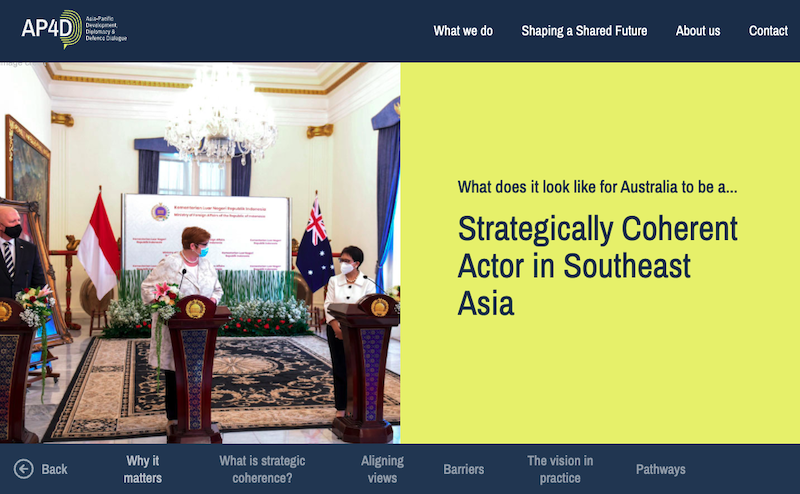RICHARD MOORE AND MELISSA CONLEY TYLER. How do we get Australia to be a strategically coherent actor?
February 17, 2022
The prize of strategic coherence is to have Australia’s overarching policies, programs and key agencies pulling broadly in the same direction in pursuing its international policy.
It is very difficult for a country to have various elements of government working together in a single cause. For example, Australia’s independent Future Fund has been criticised for investing in companies linked to Myanmar’s military contrary to diplomatic efforts to cease the provision of arms and assistance. Thus the desire for greater strategic coherence.
Strategic coherence is about “getting our act together”, making the most of strengths and reducing weaknesses. Strategic coherence does not mean there will be no institutional conflicts, but in a business and bureaucratic sense, strategic coherence is about taking a ‘systems approach’: aligning strategies, people and budgets behind shared priorities. It is about different parts of government and potentially, wider Australian society utilising their capabilities within an overall game-plan that maximises the chances of success. It necessitates first, having clear and shared goals and, second, working together to see that they are achieved.
A recent report by the Asia-Pacific Development, Diplomacy & Defence Dialogue sets out pathways for how Australia can be a strategically coherent Actor in Southeast Asia.
Strategic coherence is hard because people have different visions on big strategic questions, because they are divided into different institutions with their own distinctive cultures and because it is difficult to create coordination systems.
To increase strategic coherence, we need to work on all of these levels.
First, Australia needs a single vision for its international engagement. A comprehensive integrated framework provides Australia with a strategic grand narrative and a unified approach to Australia’s international relations. One way to achieve this is to institute an integrated strategic review, along the lines of the one recently conducted by the United Kingdom, rather than separate white paper planning processes for defence, foreign affairs and development. As part of this, credible, funded roadmaps can be developed to set out how objectives will be achieved, aligning programs, policies and budgets with this goal. This provides a base to integrate Australia’s strategic planning and coordinate its international assets.
Second, steps need to be taken to promote a whole-of-government strategic culture. This includes encouraging greater movement and interchange of senior personnel: for example, between development, diplomacy and defence, between policy and program domains, and to-and-from think tanks and the private sector. Whole-of-government processes for setting and assessing international strategies, joint scenario planning and interoperability exercises all help build a broader, unified strategic culture. This helps to break down silos and build a deeper, whole-of-government culture.
Finally, there needs to be a strategic system that brings together the different elements of international statecraft. This should include a whole-of-government strategic budgeting process and an upgraded cross-government strategic performance assessment system. This will ensure that the overall system monitors and makes course corrections to support strategic coherence
To ensure the balancing of hard and soft power, short and long-term considerations and opportunities as well as threats there needs to be a body that takes the lead in international coordination.
System level international relations coordination in Australia falls almost exclusively to the Secretary’s Committee on National Security. This mechanism is essential, but insufficient. There is an argument that the Department of Foreign Affairs and Trade should primarily hold this role, but it is not clear that as it currently stands has the clout or resources to discharge the responsibility effectively. One option is to ensure that it does. Another is to mandate and resource the Department of the Prime Minister and Cabinet to undertake the job, carrying as it does the authority of the highest office in the land. Either way, a broader process of policy development and coordination is needed to support ministerial decision making. Such arrangements might allow for the evolution of an Australian National Security Council.
It is important to note that while Australia’s overarching strategic objectives ought to guide all of its international work, the role of each actor in achieving these objectives may be distinctly different. Differences in mission and mandate should be recognised and agencies and programs allowed to specialise in what they do best. For example, while development cooperation can play useful roles in providing fast, flexible and responsive assistance, its key and unique value-add is in making lasting contributions to long-term development and relationship building.
The prize of strategic coherence is to have Australia’s overarching policies, programs and key agencies pulling broadly in the same direction. At a time that Australia’s international challenges have increased, this is what will enable Australia to step forward confidently in engaging with the world.
Richard Moore is founding co-convenor and Melissa Conley Tyler is program lead at the Asia-Pacific Development, Diplomacy & Defence Dialogue (AP4D). This piece draws on a paper recently published by AP4D “What does it look like for Australia to be a Strategically Coherent Actor in Southeast Asia”. They thank all those involved in consultations to produce this report.

